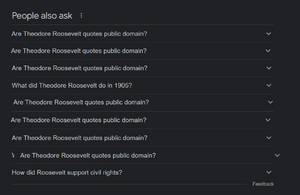User:Ssstephen/Reading
oh this one?
Scripts, Grooves and Writing Machines, Lisa Gitelman
Print culture and non print media evolve in mutual inextricability. The phonograph and contemporary inscriptive forms were deeply dependent upon reworkings of the social and economic relations of textuality, of print culture and print capitalism. They engaged literacy practices in toto, the cognitive and the somatic, the semiotic and the social. They helped question authors and readers as subjects and modify the experienced subjectivities of speakers, performers, publishers, and literates. In doing so they kept intervening into dynamic constructions of private and public, community and difference. p13
"Our copyright laws urgently need revision. They are imperfect in definition, confused and inconsistent in expression; they omit provision for many articles which, under modern reproductive processes, are entitled to protection; they impose hardships upon the copyright proprietor which are not essential to the fair protection of the public; they are difficult for the courts to interpret and impossible for the Copyright Office to administer with satisfaction to the public." [1]
Calligraphy for Computers, AV Hershey
The power of language in Jewish Kabbalah and magic: how to do and undo things with words, Agata Paluch
Literary Machines, Ted Nelson
(reading method note: read chapters 1 & 2 with no writing/notetaking, now re-scanning and writing these notes)
TN shows a diagram of "Ordinary" Hypertext which he proposes is a simplification of a (his) bigger more unifying idea. But surely there are more "Weird" Hypertexts? "Different" Hypertexts, "Strange" Hypertexts, "Outside" Hypertexts.
Check out Douglas Engelbart's NLS at Stanford Research Institute.
The reason that it (Project Xanadu) has taken so long is that all of its ultimate features are part of the design
Again this seems super prescriptive to me, not sure if I like that. No room for adaptation of structure, this is apparently the ultimate superstructure. ("unified structure to handle it all", "clean design", etc etc words that start warning signals for me)
TN seems to me to have some hidden/unaddressed desires to make this a corporate or commercial structure, in particular on page 0/6 where he compares Xanadu to Xerox Corporation (even the name dude), and page 0/13 where he offers new recruits "a small chance of fame and fortune".
THE BOOK STOPS HERE.
Ex TOT DAG: Expanding Tissue of Text, Data and Graphics (p. 0/9)
And publishing--ah consider what publishing will become
I like the optimistic rhetoric though and definitely exciting to read.
Check out The Problems of Hypertext (Chapter 3 of this book?)
This book too is hardly everybody's " cup of tea[quote added], since there is not much choice among its sequences
p.1/14 Note: I added the link, it there a protocol for this? I have adapted the more traditional [emphasis added]
Hypertext referred to as "nonsequence". In my experience it is more a multitude of sequences, this is what I assumed the hyper- part meant. p.1/15
"Colored links" p.1/15: Interesting contrast to my interpretation of p.0/2 "Ordinary" Hypertext as part of a prescriptive system.
"Compound hypertext" p.1/16: In general the tone of this chapter sits with me better. I think TN is presenting the same ideas but without the intense rhetoric of the start.
Pictures and diagrams are intrinsically nonsequential
p.16 (mkay)
Talmud as hypertext p.1/16: a body of accumulated comment and controversy
Admitting hypertext is not from the future, I'm into this.
It is my belief that this new ability to represent ideas in the fullness of their interconnectedness will lead to easier and better writing, easier and better learning, and a far greater ability to share and communicate the interconnections among tomorrows ideas and problems
p.1/19. Again with the uber-optimistic futuristic rhetoric imo. I get this is still chapter one of the book but I see no space in his language for considering the potential issues of this new system. Where's my hoverboard?

